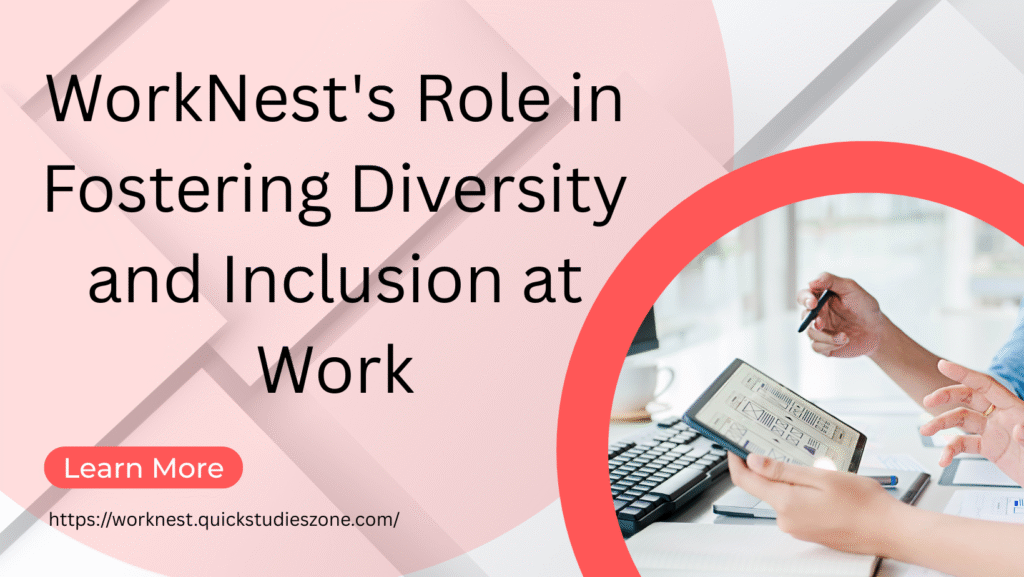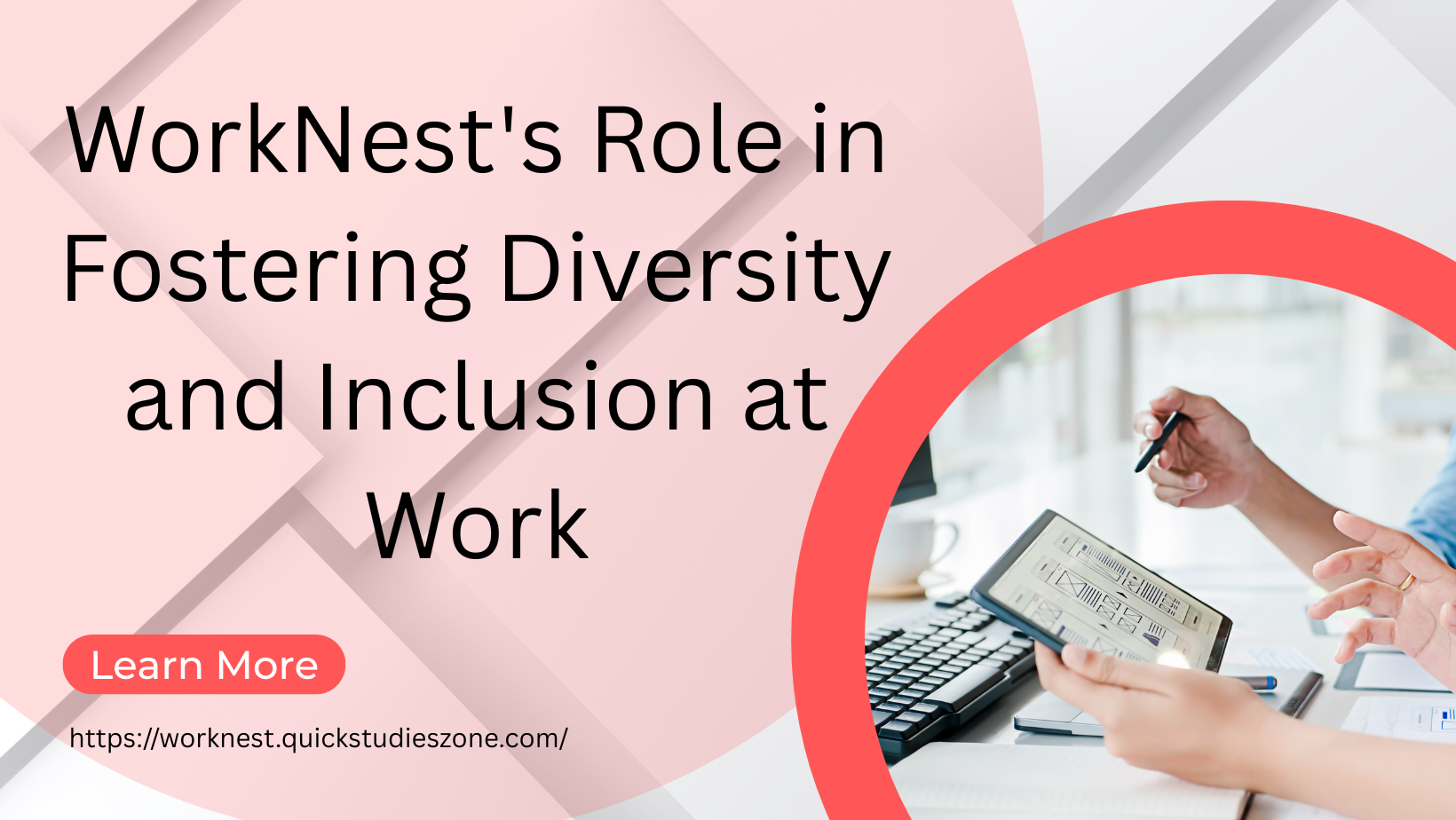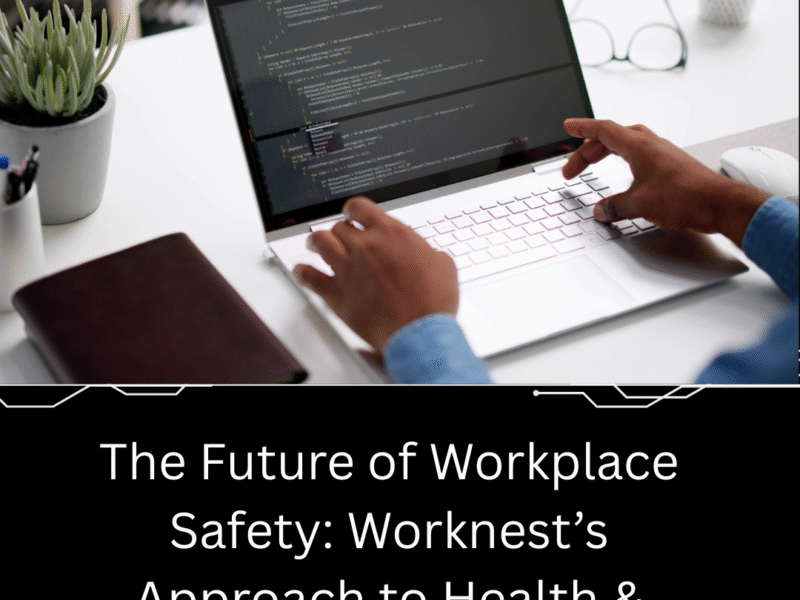-
The contribution of WorkNest to Diversity and Inclusion in the Workplace.
In the modern dynamic world, organisations are beginning to realise that success is not merely about profits, efficiency and technology but also about people. WorkNest’s Role in Fostering Diversity and Inclusion at Work. Recruiting rich talent and providing an inclusive work environment where each individual feels included, listened to and empowered has been a key source of innovativeness, engagement, retention and reputation. One of the firms that are taking this seriously is WorkNest, an HR, employment law and health and safety support company headquartered in the UK. WorkNest contributes to the issue of diversity, equity, and inclusion (DEI) through its policies, training, values, and culture.
In this post, we will discuss the role of WorkNest with regards to DEI, tangible steps that it has made, outstanding issues, and what other organisations can learn.
What is WorkNest?
A brief introduction to the company before getting into its DEI activities:
WorkNest provides HR, employment law and health and safety support services, such as technology platforms.
It has expanded by acquisition and now has operations in various locations in UK as it serves both SMEs and larger customers.
WorkNest has its key values that include Integrity, Excellence, Teamwork and Inclusion.
The latter value, Inclusion, is the core of the way that WorkNest functions internally and serves its clients.
Why Diversity, Equity and Inclusion Matter.
To contextualize the work of WorkNest, the following are some of the larger reasons why DEI is now necessary:
Legal & Regulatory Requirements -Equality, anti-discrimination, disability, harassment laws etc. dictate on employers. Breaking the rules may result in severe legal and reputational repercussions.
Employee Wellbeing and Engagement- Employees work better when they feel part of the organization, when they are treated respectfully, and when they are allowed to be who they are at work. Psychological safety enhances innovation, retention, decreases employee turnover.
Business Performance – Diversity may provide a broader range of thinking, improved decision making, increased innovation. Inclusion should however come after diversity because nothing can bring dissonance like diversity without inclusion.
Reputation & Recruitment – Reputed to be inclusive organisations gain better talent, and can also tend to have a wider applicant base.
In this context, WorkNest has undertaken actions to be in line with these imperatives.
WorkNest’s DEI Initiatives
The primary ways that WorkNest promotes diversity, equity, and inclusion are as follows, according to the information available:
1. Core Values & Culture
WorkNest values are Inclusion, as well as Integrity, Excellence and Teamwork.
The importance of being yourself / bringing your real self to work is highlighted: they also motivate employees to be themselves. Defining protective zones, letting all people thrive.
This basis is important: values establish an expectation of behaviour, culture and how policies are interpreted and applied.
2. Inclusion Alliance and Allies.
WorkNest maintains an internal team (The Inclusion Alliance) comprised of allies throughout the business that contributes largely to awareness and advocacy of DEI work.
The friends contribute to popularising smaller adjustments that, however, produce huge effects, e.g. awareness, education, reviewing policies, etc.
Such peer-led, grassroots DEI effort can frequently contribute to credibility and buy-in, as it does not just emanate out of leadership but numerous sources within the company.
3. Data‑Driven Understanding
In recent years, WorkNest has gathered information on diversity to learn more about the composition of its workforce, so that its policies and strategies could be more knowledgeable.
It is imperative to know your present condition before you are able to gauge progress, establish benchmarks, and detect gaps (e.g., gender representation, racial / ethnic diversity, disability, etc.).
4. Policies & Continuous Review
WorkNest conducts a review of its policies and processes to make sure they are fair and equal opportunity. For example:
In employment, they also pledge to treat employment applicants equally, as well as making amends where required (such as by disabled applicants or those with special needs).
According to them, all applicants, colleagues, clients are expected to be treated with respect.
This implies, not only paper policies, but a focus on their review and implementation.
5. Training & Education
WorkNest has a course in Equality, Diversity and Inclusion training. Key features:
Knowledge on EDI concepts (theory + practice) to ensure that people can be the first example.
Knowing about legal framework, safeguarded features, what segregation / harassment is, how to take action.
Various delivery formats (face-to-face, virtual) according to necessity.
Training assists in creating awareness, combating unconscious bias, and providing individuals with actual tools.
6. Wellbeing, Employee Engagement and Supporting Authenticity.
DEI could not be promoted through recruitment of diversity but by ensuring that people feel like they are a part of the company.
The Wellbeing Charter of WorkNest underlines the fact that employees should be themselves, that there is nothing wrong with saying I am not okay, etc.
Their culture includes remote working/hybrid, flexible working, and it assists individuals facing various life situations.
Encouraging the rest of the colleagues to speak up, to raise concerns when something is not right, to provide safe spaces.
7. Extrinsic Arrangement and Signatory Obligations.
WorkNest is a contractor of the Armed Forces Covenant. That is an external pledge to take care of veterans, military spouses and partners, etc.
Disability Confident: WorkNest is a Disability Confident Committed. This means that there is a formal obligation to accommodate handicapped employees, eliminate obstacles, etc.
These alignments provide an assurance of accountability, transparency and also provides an indication to the candidates, stakeholders that the firm is committed to inclusion.
8. Recruitment & Hiring Practices.
The promise of diversity and inclusion can be mentioned on advertised offers and changes can be made on behalf of applicants who require it.
Job descriptions are inclusive. Recruiting teams look at procedures.
Impacts & Evidence
From what is publicly visible, what impact does WorkNest seem to be having? Some of these are directly reported; others are inferred.
- On employee perception, their Glassdoor page shows relatively high scores around “Equality, culture & values” and “Equality, diversity and inclusion” categories. Employees comment favourably that DEI isn’t just rhetoric but part of how WorkNest operates.
- The inclusion of DEI in values, in hiring practices, in training, tends to reduce legal risk, improve morale, and help with retention. Although I have not found public data (in sources I checked) on exact figures (e.g. turnover, retention by demographic), the indications are positive.
- By collecting diversity data, having inclusion‑allied teams, WorkNest is positioning itself to measure change, set goals, track prog
- Difficulties and Future Development.
There is no organisation that is flawless and there is always the room of doing more. According to what is known and what generally will be needed by DEI, these are potential challenges or developmental areas of WorkNest, and, in general, companies performing similar work.
WorkNest’s Role in Fostering Diversity and Inclusion at Work

.Transparency & Reporting
Diversity metrics (e.g. by gender, race/ethnicity, disability, etc.) should be publically declared. Unless WorkNest has published detailed reports already, it can be used to gain trust, demonstrate accountability.
Others also to report on progress over time (year on year) which DEI initiatives are and are not working.
.Setting Clear Targets
It is useful to have quantifiable, time-limited targets (at least, in terms of representation, e.g. make the senior leadership X X more representative of underrepresented groups by year Y).
Intersectionality
DEI does not make dimensions such as race, gender, disability, socioeconomic background, etc. separate silos. Most workers are cross-identified; the policies must take intersectionality into consideration.
.Long-term Training & Bias Reduction.
Occasional training will work, but continuous training is more appropriate.
More experiential learning can include unconscious bias training, inclusive leadership training, mentorship programmes, reverse mentoring, and more.
Inclusive Leadership
Managers and leaders should be completely purchased into inclusion. They require instruments to facilitate inclusive teams, to lead and not to manage but to lead and to handle microaggression, to make sure everyone is heard.
Embedded Practices
Inclusion has to manifest itself in daily practice in addition to policies and training: performance reviews, promotions, reward systems, communication styles, meetings, recruitment, work design.
Employee Feedback & Voice
.Ensuring that underrepresented people have safe, credible and effective forums to share experiences, suggest improvements.
-
- WorkNest’s “safe space”, “speak up” language helps, but what are the formal channels? E.g. anonymous surveys, exit interviews, focus groups etc.
2.Retaining Diverse Talent
- Hiring a diverse workforce is only part of the work; retention, growth, inclusion, equitable opportunities for advancement are just as critical.
- Impacts & EvidenceBased on what can be seen publicly, what effects does WorkNest appear to be experiencing? Some of these are stated directly; others deduced.In terms of the employee perception, their Glassdoor page demonstrates rather high ratings in the categories of Equality, culture and values, as well as Equality, diversity and inclusion. WorkNest’s Role in Fostering Diversity and Inclusion at Work. Employees are making positive remarks that DEI is not an empty rhetoric but a part and parcel of how WorkNest functions.It will assist with retention, decrease legal risk, and boost morale when the DEI are included in values, in the hiring process, in training. I have not discovered public data (in sources that I reviewed) on specific numbers (e.g. turnover, retention by demographic) but the signals are optimistic.With the gathering of diversity data, inclusion-allied teams, WorkNest is making strides to gauge change, set objectives, monitor the progress.
Difficulties and Future development.
There is nothing like a perfect organisation and there can always be more work to be done. These are potential challenges or areas of growth of WorkNest, and, in general, companies engaged in similar work based on what is known and what DEI generally demands.
Transparency & Reporting
Diversity measures (i.e. by gender, race/ethnicity, disability, etc.) should be publically disclosed. In case the detailed reports have not been published yet by WorkNest, then they can create trust, demonstrate responsibility.
Also communicating progress over time (year on year), which DEI initiatives succeed and which fail.
Setting Clear Targets
Having specific, time-limited objectives (e.g. position more underrepresented groups in top leadership to X by Y year) can aid in translating intent to outcome.
Intersectionality
Ensuring DEI does not use dimensions such as race, gender, disability, socioeconomic background, etc. as individual silos. WorkNest’s Role in Fostering Diversity and Inclusion at Work. Most of the employees possessing conflicting identities, policies ought to consider intersectionality.
Constant Training and Bias Reduction.
A single training session is useful, although continuous development is preferable.
Greater impact may be made with unconscious bias training, inclusive leadership training, mentorship programmes, reverse mentoring and more experiential learning.
Inclusive Leadership
Managers and leaders should be in a state of being fully purchased into inclusion. They should have mechanisms to guide diverse teams, work in equity, deal with microaggressions, make everyone heard.
Embedded Practices
In addition to policies and training, inclusion should be reflected in the daily practice: performance reviews, promotions, reward systems, communication patterns, meetings, recruitment, work design.
Employee Feedback & Voice
Providing underrepresented individuals with safe, reputable and useful platforms to exchange experiences, propose changes.
The language used under safe space and speak up of WorkNest assists, but what are formal channels? E.g. anonymous surveys, exit interviews, focus groups etc.
Retaining Diverse Talent
Recruitment of diverse workforce is not the end of the work, retention, development, inclusion, fair chances of promotion are equally important.
Lessons and Best Practices that can be learnt by other Organisations.
An example of WorkNest teaches other companies some lessons.
Practice Why it is useful Key Ingredients
Begin with values Incorporating inclusion into the values will ensure that DEI is embedded in how we conduct business, rather than an independent initiative. Leadership buy-in; regular communication; relating values to day-to-day behaviour.
Data & measurement You can not improve what you do not measure, data can be used to identify gaps and gauge progress. WorkNest’s Role in Fostering Diversity and Inclusion at Work. Gather pertinent, voluntary information; maintain confidentiality; establish goals; check-in periodically.
Employee-driven activities and supporters The ability to involve people on various levels is credible and leads to engagement. Give voice, resource and empower allies; permit feedback and suggestions.
Training + policy + culture Policy out of culture, culture out of policy. Several interventions; enforcement; culture-building in the long-term.
Flexibility & accommodations Assists in making sure that individuals who are in various situations of life are accommodated. Bending of work hours, accommodation of schedules, equity in leave systems etc.
Openness and accountability to outsiders Establishes good credibility among workers, clients and society. Report; subscribe to external charters; do not greenwash.
- WorkNest’s “safe space”, “speak up” language helps, but what are the formal channels? E.g. anonymous surveys, exit interviews, focus groups etc.
Lessons and Best Practices that other Organisations
As the example of WorkNest shows, there are some lessons other businesses can learn.
The importance of the Role of WorkNest in a Larger Context.
The question of why the activities of WorkNest are especially applicable is helpful not just to its employees and clients, but also to the entire ecosystem.
Supporting SMEs- WorkNest has numerous small and medium enterprises (SMEs) as clients. Because SMEs tend to lack internal HR and legal frameworks, providers of advice on DEI such as WorkNest can disseminate good practice.
Capacity Building – The provision of training and how to do DEI information enables other organisations to become better and multiply the effect of WorkNest.
Legal & Ethical Leadership -They are involved in employment law. Businesses working in this area are uniquely positioned to assist others to comprehend legal requirements regarding discrimination, equality, etc., and good ethical practice.
Influence through Recruitment and Cultural Sign-posting- WorkNest demonstrates that it has joined the ranks of employers with the features described above and attracts talents foreseeing them accordingly. That assists in changing market norms.
Potential Roadmap: Where WorkNest has the potential to go.
In order to expand on what it has done, the following are recommendations of next steps WorkNest could take (most of them are extensions of their existing activity):
Issue a DEI Report – An open report which includes existing demographics, progress, policies, challenges. May have pay gap data, representation data, demographic turnover.
Establish specific Goals – To be represented in the leadership, gender balance, disability, underrepresented ethnic groups, etc.
Improve Inclusive Leadership Programmes – Design management and leadership training around inclusive leadership, bias reduction, team management.
Mentorship / Sponsorship Programmes- Pair underrepresented employees with older sponsors or mentors.
Review Reward and Promotion Processes- Be fair, transparent and inclusive in relation to promotion, bonuses and recognition.
Collect and Nurture Employee Voices -Focus groups, listening, story sharing, maybe even employee resource groups.
Embed DEI into Client Service – Because WorkNest serves clients, they may assist clients to audit their practices in DEI, or provide advisory services, packages, tools in areas such as inclusive hiring, equitable HR practices, etc.
Uphold Culture Ongoing – Survey data (e.g. psychological safety, belonging), feedback loops; possess mechanisms of responding to emerging issues.
Conclusion.
WorkNest is a company that is not just considering diversity, equity, and inclusion as a tick mark in compliance or simply a PR initiative but as a fundamental element of its identity, values, culture, and operations. Its values, its internal Inclusion Alliance, its data collection, its training, its policy reviews and promises such as its Armed Forces Covenant and its Disability Confident have created the majority of the fundamental building blocks of a truly inclusive organisation.
As with any organisation, there is still room to improve: more openness, clearer goals, continuous feedback and leadership training will help get beyond the stage of good intent + policies to systemic change + measurable impact.
In companies that are attempting to strengthen DEI, WorkNest provides lessons: make inclusion part of your value statements, prepare the top leadership, quantify what you treasure, engage employees, and make inclusion something that you practice day in day out, rather than a periodic thing.
Also, a pull arrangement of particular quotes of the WorkNest employees or case-studies or any variation of this post that suits a given audience (e.g., HR managers, business leaders) can be done to make the end product sharper.


